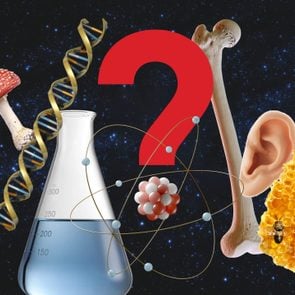This Is One of the Rarest Facial Features in the World
Updated: Feb. 14, 2024

People with heterochromia have a striking and unique appearance. Are you among them?
When parents tell their children they are special and unique, they aren’t lying. With so many different features that make up each individual’s appearance, every person’s looks are totally different. That said, some facial features are rarer than others. The one that appears most infrequently (rarer than the rarest personality type and rarest eye color, though not quite as rare as the rarest hair and eye combination) is heterochromia, or having different-colored eyes.
How rare is heterochromia, and does it reveal anything about the health of your eyes or your body? We have the answers, along with other interesting facts about this striking condition. And if you have blue eyes, don’t fret—you’re still special and unique. Brown eyes? Van Morrison wrote a song about you, and hey, maybe you have one of the rarest birthdays too!
Get Reader’s Digest’s Read Up newsletter for more interesting facts, cleaning, travel, tech and humor all week long.
What is heterochromia, exactly?
“Heterochromia is when a person’s irises are different colors,” explains Sidney Gicheru, MD, the medical director of LaserCare Eye Center in Dallas and a spokesperson for the American Academy of Ophthalmology. In case you need an anatomy refresh, the iris is the technical term for the circle on the front of the eye that contains the colored part and the pupil in the middle.
There are three types of heterochromia.
- Complete heterochromia: The most obvious form of heterochromia, it describes irises that are completely different in color. Translation: When you see someone with complete heterochromia, you’ll notice that they have two different-colored eyes.
- Central heterochromia: “With central heterochromia, there is an inner ring that is a different color than the outer area of the iris,” Dr. Gicheru says. There are two different ways this can present. In the first, most of the iris around the pupil is one color, but then it is essentially outlined with another color. In the second, there is a thin ring of one color around the pupil, then the rest of the iris is a different color.
- Partial heterochromia: In this type of heterochromia, only part of one iris is a different color than the rest of it. From far away, a person with this form of heterochromia may not appear to have different-colored eyes. But a closer look will reveal that one of their eyes is two different colors, while the other is just one.
In a nutshell: The vast majority of people have just one color in their eyes (not counting the black of their pupils). People with heterochromia have two.
How rare is heterochromia?
Heterochromia is extremely rare, affecting less than 1% of the world’s population, or fewer than 78 million people worldwide. If that sounds like a lot, consider that between 70% and 80% of people, or about 6.4 billion people, have brown eyes—by far the most common eye color on the planet.
Rounding things out are blue eyes, the second-most-common eye color, at 8% to 10% (or roughly 800 million people); hazel eyes and amber eyes at 5% (or 400 million people) each; gray eyes at 3% (or 240 million people); and green eyes at just 2% (or 160 million people). So the answer to the question “How rare is heterochromia?” is: very. That said, it’s not as rare as the rarest blood type, which is found in fewer than 50 people worldwide!
While super uncommon in humans, heterochromia is actually fairly common in dogs. (That’s a fun science fact for you!) Breeds that are most likely to have two different-colored eyes include Australian cattle dogs, Australian shepherds, Great Danes and Siberian huskies.

What causes people to have different-colored eyes?
The most common cause of heterochromia (and the cause behind everybody’s eye color) is genetics. Your genes determine how much melanin, a brown pigment, is present in each eye. More melanin means darker eyes, while less melanin means lighter ones.
Sometimes people are just born with it, according to Dr. Gicheru, the same way that some people are born with blonde hair and some are born with red. In this case, it is called congenital heterochromia. “It is usually harmless, but it can sometimes be a symptom of disease,” Dr. Gicheru notes.
When an infant is born with different-colored eyes or develops heterochromia shortly after birth, it can be a symptom of another eye condition, such as Horner’s syndrome or Sturge-Weber syndrome. “Horner’s syndrome results from a lesion to the nerve pathway that supplies the head and neck region. It can lead to heterochromia because the development of the pigmentation of the iris is controlled by these nerves,” explains optometrist Kerry Gelb. “Sturge-Weber syndrome is a rare neurological disorder present at birth and characterized by a wine-stain birthmark on the forehead and upper eyelid on one side of the face.”
A check from an ophthalmologist can determine if one of these, or another eye condition, is the cause, or if the heterochromia is benign (which it usually is).
Can you develop heterochromia as an adult?
Yes. Heterochromia can appear later in life. Known as acquired heterochromia, this is often nothing to worry about, though as with any medical condition, sometimes it’s a sign of a problem. “There are several potential causes a doctor will check for,” explains Dr. Gicheru, “such as iritis or uveitis (swelling of the eye), bleeding in the eye, glaucoma and/or some of the medications used to treat it, diabetes mellitus, ocular melanosis and central retinal vein occlusion, among other eye diseases.” If an ophthalmologist determines that one of these is behind the change in eye color, they will recommend treatment for that specific issue.
When should you see a doctor for heterochromia?
“It is always a good idea to see an ophthalmologist when you notice any change to your eyes’ appearance,” says Dr. Gicheru. This applies regardless of when the heterochromia develops. “An ophthalmologist is trained to spot and treat eye disease,” he adds. “If they conclude that there is no other health issue with the eye after an exam, heterochromia is nothing to worry about. If heterochromia is caused by another underlying condition, an ophthalmologist can recommend the right treatment.”
Who are some famous people with heterochromia?
There are quite a few of them, given how rare heterochromia is. Perhaps it’s because different-colored eyes are so striking, which helps the person sporting them stand out from the pack—something that’s especially helpful in a field as competitive as acting. Some famous folks with heterochromia include:
- Elizabeth Berkley, actress
- Kate Bosworth, actress
- Henry Cavill, actor
- Jennifer Connelly, actress
- Alyson Hannigan, actress
- Josh Henderson, actor
- Mila Kunis, actress
- Jane Seymour, actress
- Max Scherzer, professional baseball player
- Christopher Walken, actor
- Olivia Wilde, actress
Now that you’re well versed on this rare eye-color condition, discover the rarest zodiac sign and the rarest animals on earth.
Sources:
- Sidney Gicheru, MD, medical director of LaserCare Eye Center in Dallas and spokesperson for the American Academy of Ophthalmology
- World Atlas: “The World’s Population by Eye Color”
- Kerry Gelb, optometrist
- American Academy of Ophthalmology: “Heterochromia”




















